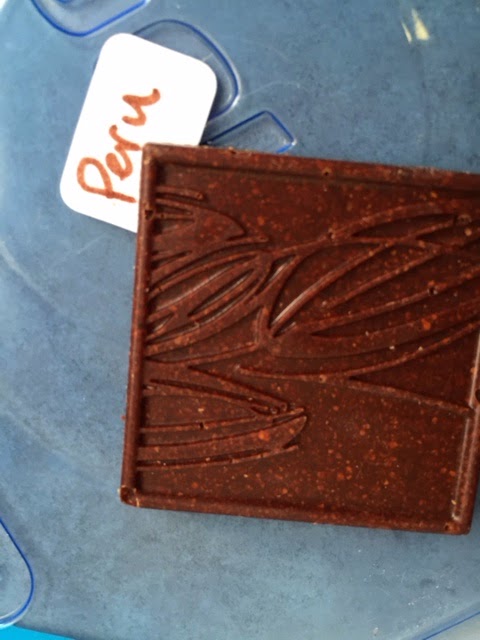I wanted to experiment by making Madagascar origin chocolate with Soma's roasted nibs, and then following the exact same recipe a second time to make Peruvian origin chocolate from other organic roasted nibs that I had on hand. My result was two very different tasting chocolates.

I used the coffee grinder to grind the chocolate into a liquid, and because of that I was forced to add a little melted cocoa butter to each batch. My grinders are getting a bit old, so admittedly the chocolate was on the crunchy side.
Upon first taste, I was delighted with the Peruvian chocolate that I made, and completely appalled by the Madagascar. Why? Although the Madagascar chocolate was slightly smoother than the Peruvian, it was so acidic that is was nearly unpalatable. The Peruvian, on the other hand, was sweeter and although there was some acidity, it was mild compared to the Madagascar chocolate.
So in order to save the Madagascar chocolate, I decided to see if there is any truth to this 'chocolate aging' process that I hear so much about. Many chocolate makers believe that an important part of process of bean-to-bar chocolate is to age the chocolate for at least 30 days. But not all do this. So I decided to experiment with the few pieces that I had left to see if that would help.
I waited (not so patiently) for a month and what do you know? After 30 days, the Madagascar chocolate became more palatable and all the common fruity flavours that can be tasted from that origin became identifiable. The Peruvian chocolate got even better, with a slight floral and sweet flavour and very low acidity.
So what did I learn? Aging certainly helped both origin chocolates, however, it was not necessary with the milder Peruvian batch, and it was necessary with the Madagascar. I am sure that technique, better equipment and a good conche would have done more justice to the Madagascar beans. But from this experiment, it is clear that a good chocolate maker should assess their beans, and then adjust the aging accordingly.
If you want to learn more about aging chocolate, Ritual Chocolate has a great article on their website here: http://www.ritualchocolate.com/aging/.

Have you thought about getting a wet stone grinder? :)
ReplyDeleteIch habe die Kaffeemühle, um die Schokolade in eine Flüssigkeit zu schleifen, und aus diesem Grund war ich gezwungen, ein wenig geschmolzener Kakaobutter zu jeder Charge hinzuzufügen. Meine Mühlen sind etwas in die Jahre, so zwar die Schokolade war auf der knusprigen Seite.
ReplyDeletewww.fifa-munzen.de
http://www.fifa-munzen.de/
KOLKATA BEAUTY
ReplyDeleteGIRLS NUMBER WHATSAPP
HIT GIRLS
WHATSAPP NAMBAR GIRL
TOP 10 SEXY GIRLS
ROYAL HOTEL KOLKATA
HOT MODELS LIST
SLUTS IN BANGALORE
HOTEL IN KOLKATA NEAR PARK STREET
KOLKATA 24X7 BANGLA
FEMALE ESCORT KOLKATA
THE MOST SEXIEST GIRL IN THE WORLD
GIRLFRIEND KA NUMBER
ESCORT WEBSITE
KOLKATA GIRLS WHATSAPP NO
HOT GRLS
SHOBHA THEATER
SEXY NAMES FOR GIRLS
ONLINE PROSTITUTE
DATING WOMAN IN KOLKATA
KOLKATA CALL GIRL MOBILE NO
SONAGACHI PHONE NUMBER
PATNA GIRL WHATSAPP NO
WHATSAPP NUMBERS GIRLS
CALL PROSTITUTES
HOTELS IN NEW TOWN KOLKATA
WHAT IS ESCORT
SEXIEST WOMEN PICS
WWW KALKATA SEX COM
HOTEL HOWRAH
NIGHT SEX GIRL
KOLKATA RED LIGHT AREA PICTURE